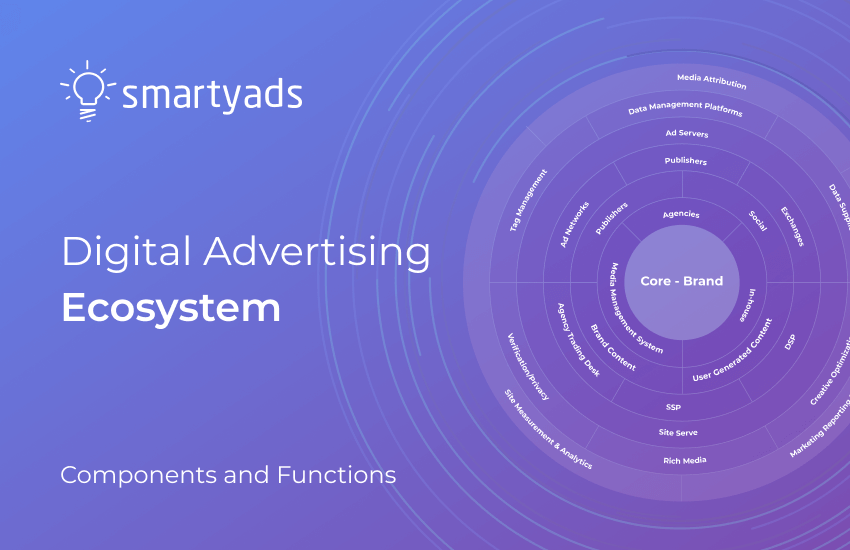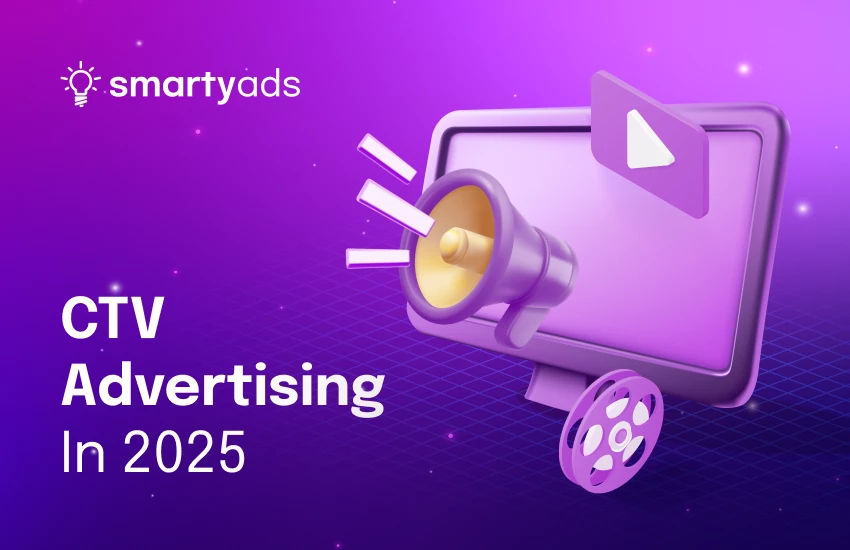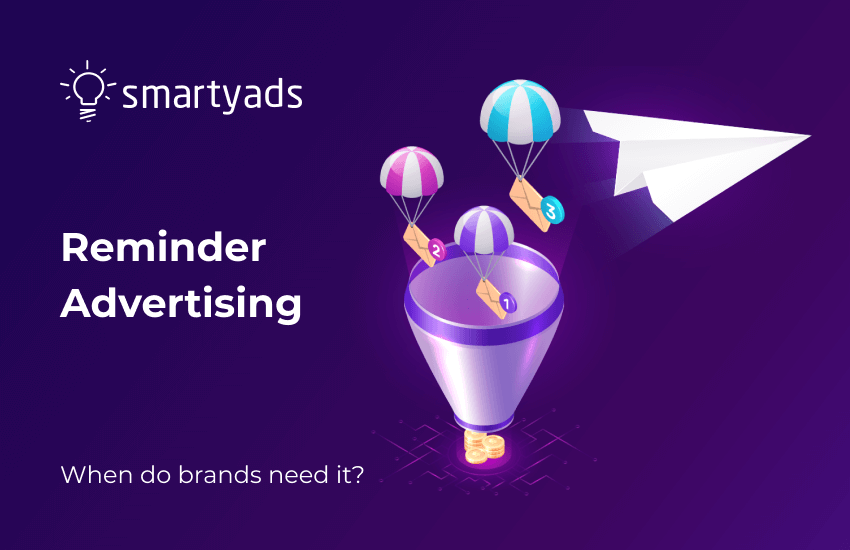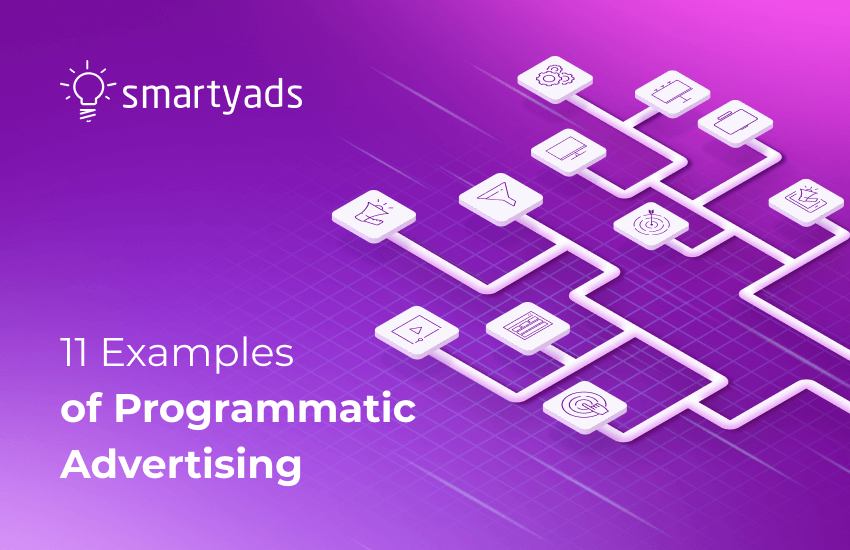Just a couple of decades ago the notion of the most influential “media platforms” included only TV and newspapers, and the term online advertising ecosystem was practically non-existent. But the pace of technological progress got so impressive that within this relatively short period a traditional advertising ecosystem acquired hundreds of new channels and formats, which in turn merged into something even more complicated - the digital advertising ecosystem.
Today’s digital marketing industry includes numerous platforms, solutions, and players, all of which are united by a complex system of relationships focused on their shared mission - a successful and relevant online ad delivery. At its current state digital ad ecosystem supports lots of various digital ad formats, sizes, channels, as well as targeting solutions, and includes numerous tools that allow both publishers and advertisers to build a successful programmatic ads strategy. Although at the first glance online advertising and the programmatic ecosystem, in particular, might look just too complicated, one can start getting a deeper understanding of the industry once they explore the main elements and their functions within the system. In this article, we are going to review this mechanism from different angles and explore how it helps advertisers and publishers reach their goals. But first, let us start with the evolution of the digital advertising ecosystem.

Online advertising ecosystem evolution
In the early days of traditional display advertising at the beginning of the 20th-century publishers and advertisers were practically the only players of the ad ecosystem. A typical publisher was producing a newspaper aimed at a specific audience interested in the media's specific content. An advertiser interested to reach this audience with their message would communicate with the publisher regarding their ad space in this paper. If the negotiations were successful, they would then strike a deal and the advertiser would pay an agreed price for ad placement scheduled for a certain period. The same way was applied for trading the ad inventory for radio and television.
1970 - the beginning of the computer era also marked the origin of online advertisements. Although this was a huge step, the real dawn of digital ads started in 1994 with the first digital display advertising banner rolled out by AT&T at the Wired Magazine. Back in these times, the global number of internet users was significantly lower than nowadays - only 16 million users in 1995. But this number was steadily increasing year over year and quickly surpassed 558 million by 2002.
As technology began to develop faster and faster, the traditional advertising marketplace also started to change, adjusting to the evolving world and its new dimensions. The process of media trading also became more complex and data-driven, involving more parties and software for managing the campaigns. In 2020 within the martech alone the number of solutions has grown 13.6% up to a total of 8000 solutions compared to 2019. According to Emarketer, the total digital ad spending reached $332.84 billion in 2020 and is projected to reach $526.17 billion by 2024.
The structure of the advertising ecosystem
The first marketing researchers started to study the ecosystem as early as 2009. Their main focus was centered around the buy and the sell sides back then, and of course the user's attention. Once the ad exchanges came in, automated media buying started to develop into something we now know as the concept of programmatic advertising. Over the past decade, this relationship has grown into a complicated ad ecosystem so broad that some of its visualizations include up to 13 sectors of different sizes and shapes.
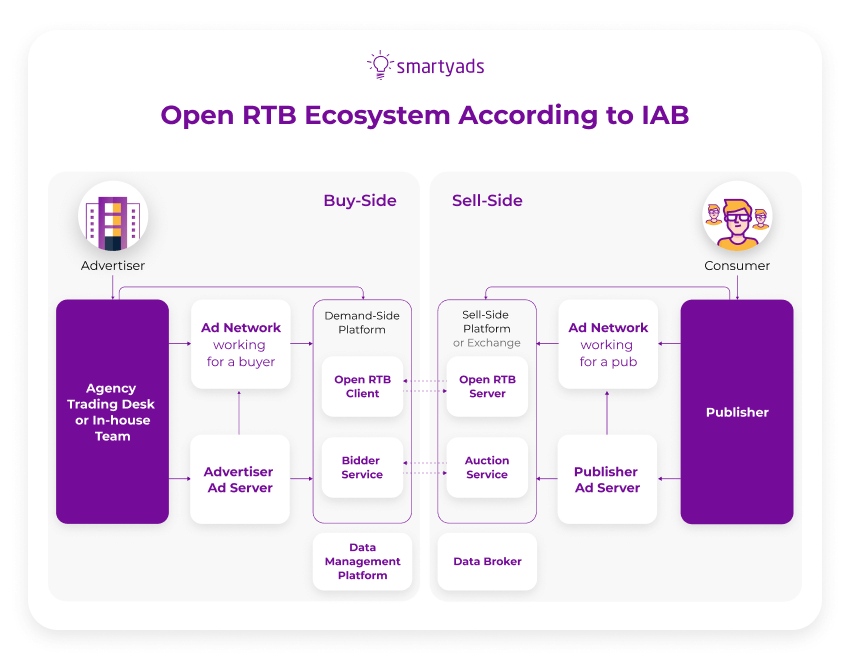
At the same time, some researchers prefer to divide the digital advertising ecosystem into five main elements: demand side, supply side, the marketplace, the data, and the user.
- The demand side includes all kinds of media-buyers, i.e. advertisers and marketing agencies, ad networks, demand side platforms (DSP), small businesses, and virtually anyone interested in purchasing digital ads.
- The supply side includes direct publishers and inventory vendors, such as publishers networks, supply side platforms (SSP), or any other authorized seller of the given display ads inventory.
- The marketplace stands for all kinds of platforms and environments that host the whole media buying process. It can occur in the form of direct sales or programmatic auctions, such as real time bidding. It can also differ in terms of availability - one can find both closed auctions, that can be general or niche-oriented.
- The data overlays both demand and supply sides, as well as third-party tools and ad tech vendors that help to enrich and categorize collected data. These can be customer data platforms, data management platforms, various plug-ins, data collection companies. This segment also partly includes various legal regulators of data collection and usage, such as privacy policy, data protection laws, and many others.
- Finally, the user is basically any consumer of the content whose attention the four aforementioned sides are trying to get.
Such a division perfectly depicts the system from the point of view of the inventory trading process, but when it comes to the actual communication between the brand and its potential customers it certainly lacks a couple of additional supportive layers. The International Advertising Bureau has developed its own illustration of the system, named IAB Arena, which depicts the online advertising ecosystem from a marketer’s perspective.
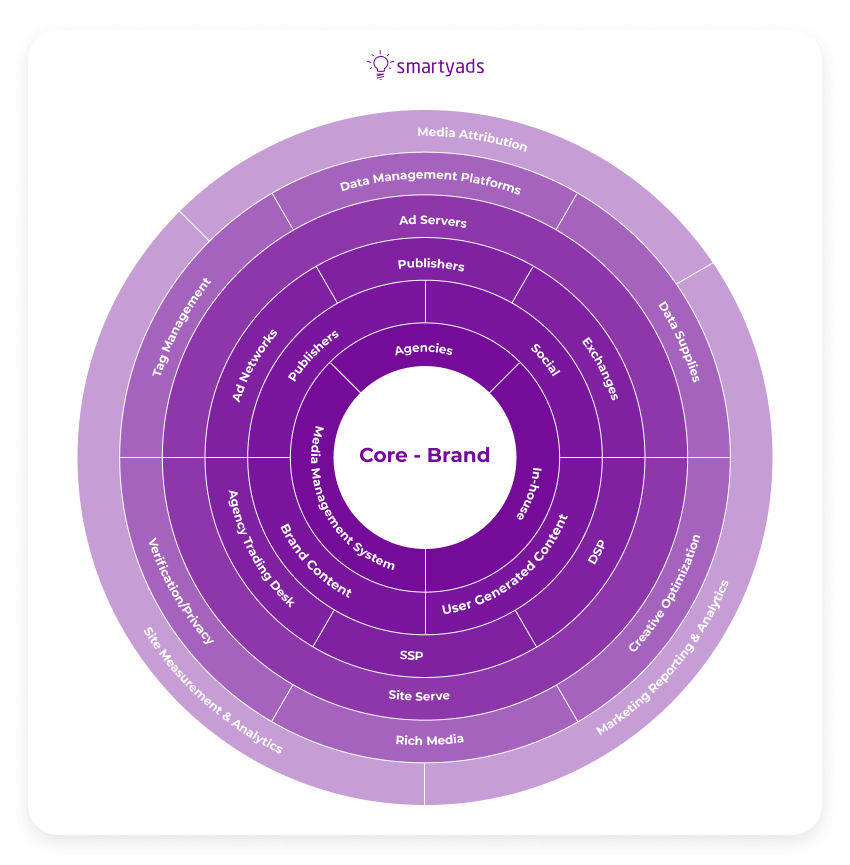
The illustration has six layers, broken down by their roles in building the relationship between the brands and their audiences. These activities are media trading, content creation, publishing, ad serving, enhancing media, and business intelligence. Each circle includes several players with the brand at the center of a diagram as the initiators of digital ads campaigns. These players each have their own role within the ad serving process and the digital advertising ecosystem in general. Let us now take a closer look at these elements, discuss their function and the position within this complicated mechanism.

Elements of the ecosystem
So far we have discussed the online advertising ecosystem in terms of history and evolution, as well as the general structure and main actors. To get a deeper understanding, however, it is essential to study the details of this structure in order to investigate their functions. We will start with the inner circles of the diagram and then gradually move outwards, comparing the main elements’ positioning within the IAB’s visualization with other classifications.
Brands as the core
At the core of the digital advertising ecosystem are brands and their marketing strategies. After all, the successful delivery of the message to the users is the primary goal of the whole system. Depending on businesses and the scope of their needs these brands can choose to build and manage their campaigns with the help of in-house marketers. They also opt for outsourcing their media-trading activities to ad agencies or use external tools like media management systems.
The content and the environment
The era of digital advertising is all about content, as it is the main element of any website or other media channels. Content creators are those in-house or freelance content specialists within the publisher's business that produce texts, images, audio, and video. From the marketer’s perspective, this type of content can be seen as a sort of environment where the ads are placed. Other types of such an environment can be found in social media, such as Facebook, Twitter, TikTok, and several other platforms, where user-generated content is the cornerstone.
On the other side, there is also brand content which includes all sorts of content created by the businesses to promote their products or services. This involves websites and special blog pages, apps, as well as native ad formats that can merge with the environment.
Media trading actors and technologies
With brands and the ad environment at the core of the media trading process, we can move on to the actual executors of the media-trading process. In the complicated world of media trading, these include not only teams of trained professionals, but also sophisticated tools and solutions that enhance their efforts.
While on the demand side, we usually have brands, marketers, and ad agencies, the supply side became somewhat more complicated over the years. The original media vendors within the traditional advertising ecosystem are the publishers - owners of TV channels, newspapers, websites, or other media channels who fill it with content and sell their ad placements. With the development of the digital advertising ecosystem, the process of predicting and filling all the inventory has become more intricate, so numerous ad tech tools have emerged to automate it.
Ad networks were among the first automation tools to enter the market - starting from the late ‘90s these platforms collected and categorized ad placements from various publishers based on niche, audiences, context, or other criteria. These were good news for publishers as such tools helped them to effectively monetize their digital assets. For the advertisers, ad networks significantly reduced the time and effort needed to find and verify placements. Plus, they helped to manage and optimize their campaigns.
Ad exchanges. Ad exchanges were developed in the mid-'00s to optimize and accelerate the media-trading process for both publishers and advertisers. If we turn to definitions, an ad exchange is a digital advertising marketplace where sellers and resellers offer inventory in bulks. Demand side then purchases this inventory based on the type of deal chosen by parties. Deals can be direct or based on auction, open, or private. The four most common types of programmatic deals include:
- Open exchange (based on open auction);
- Private Marketplace PMP (based on private auction);
- Programmatic Guaranteed (direct);
- Preferred deals (direct).
It is important to note that ad exchange is an independent entity and serves both supply and demand sides. The emergence of ad exchanges also introduced digital media auctions, such as real-time bidding.
Agency Trading Desks. There are also other entities that specialize in media trading enhancements like trading desks. Somewhat similar to ad networks, a typical Agency Trading Desk usually looks like a centralized service that integrates multiple DSPs and ad exchanges. In short, trading desks were created to help marketers build and launch their campaigns. Those can include other different tools for advertisers with data analytics, as well as campaign management and optimization.
Self-serve advertising platforms. While the main task of most DSPs, SSPs and other ad tech software is to automate as many operations as possible, some advertisers choose to retain more control over their campaigns. Here is where self-serve ad platforms come in - with the help of these tools media buyers can customize almost everything from inventory selection to the slightest details of campaign. Although utilizing these tools might require additional knowledge and experience, it is a perfect tool for marketers with narrowly-defined audiences and a precise course of action.
Demand Side Platform. Perhaps the most important platform for any advertiser. The DSPs are universal tools that allow advertisers:
- to plan,
- to launch,
- to manage,
- and to optimize their campaigns in real time and in accordance with their business needs.
This software finds suitable impressions based on the campaign parameters that advertisers choose. Then it automatically buys it for the best possible price. It provides marketers with access to countless inventory sources within a single interface and automates purchases. Such an invention makes media-buying much cheaper and more effective.
Apart from this, the DSPs are often integrated with various data analytics tools (that will be discussed in more detail throughout the next sections). Plus, DSPs also represent robust targeting solutions that help brands’ reach their exact audiences at the right time and place.
There are two types of DSPs - self-serve and managed serve. Managed-serve DSPs provide full campaign management done by specialists working with the platform. Self-serve platforms, in contrast, give advertisers an opportunity to manage and control everything about their campaigns. Self-serve DSPs also help to reduce advertising costs, as advertisers don’t pay for additional managing services.
Supply Side Platform. On the other side of the digital advertising ecosystem lies the sell-side, and the supply side platforms that represent their interests. SSPs are designed to help publishers successfully sell their inventory and fill in as many ad placements as possible. These platforms provide publishers with all the necessary settings regarding selling, management, and optimization of their advertising spaces. The primary goal of any SSP is to protect and enhance publishers’ yields, while also helping them to fight ad fraud and ensure brand safety.
Together, these entities are working to meet the main objectives of the online advertising ecosystem. With the help of these tools, marketers can easily communicate their message, while publishers are allowed to get the most profits from their placements. At the same time, there is still a long way to go in terms of the effectiveness of modern advertising strategies, which is why numerous media enhancements and data analytics tools actively expand the ad ecosystem.
Media enhancements and intelligence
Now that we have a general knowledge of the media trading fundamentals, it is time to study all those additional tools and elements that make the advertising relevant to the user. After all, meeting customers’ needs is the main goal for most client-oriented brands, so understanding their audiences and providing them with helpful content and timely offers should be the number one priority for any successful marketer. These tools include:
Data management platform. In today’s digital world there is so much data that it is becoming more and more complicated to make some sense out of it. To cope with this issue, data management platforms were designed and the process of data gathering and categorization became much simpler. The DMPs are perfect to organize data from various sources like:
- your website data
- offline and CRM data
- purchase data
- social data
- mobile data
- smart TV data
- 3rd party data
- and arrange it into audience segments for further analytics.
Apart from demographic and previous behavioral data, DMPs can collect and analyze campaigns’ performance characteristics, such as clicks, downloads, sign-ups, contact us forms, and all the other sorts of interaction with ads. Once the correlations between these actions and the brands’ ads strategy are established they are sent back to the advertisers’ platform to make the necessary targeting improvements. Then this data is applied to creatives and their design, such a process is called creative optimization. This process is reiterated as many times as necessary to achieve the best results and reach the companies’ business goals.
Customer data platforms. These are slightly more sophisticated data analytics tools that collect information from all online and offline sources into a single platform. It is then structured into user profiles that allow advertisers to create effective personalized campaigns and track their performance throughout the entire customers’ journey. Such tools should provide data safety and guarantee privacy. With such a unified customer data basis, one can orchestrate their campaigns with a brand new level of precision.
Campaign analytics platform. These are the solutions that provide additional unique insights and visualizations regarding campaign performance and media attribution. With such tools, advertisers can benefit from in-depth reports and trends analysis. On DSPs these reports are updated and adjusted in real-time, so marketers can track and study the data from the fast-paced within a convenient and unified interface.
There are also other additional services that constitute an important part of the digital advertising ecosystem. They help to refine campaigns and support vital operations within the ad delivery process. Some of these media enhancements and analytics tools noted by the IAB include:
- Tag management systems that are developed to automate and optimize the usage of ad tags. They are essential not only for measurements and reporting, but they also play a significant role in reducing page latency.
- Ad verification & privacy providers ensure proper ad delivery, viewability, as well they help to reduce ad fraud and privacy policy violations.
- Site measurement & analytics tools are used by publishers to research and optimize their digital assets’ performance.
To conclude
Numerous classifications and visualizations have been developed by the researchers in recent years to avoid confusion. Some divide the digital advertising ecosystem into 5 segments, while other visualizations include more elements. The IAB’s classification points to the brands at the center of the ad ecosystem, as their communication to the customers is the core purpose of the whole mechanism. Various types of digital media and content create an environment for tailoring ads to users. In other words, advertisers buy ad impressions from publishers based on their specific audience niches and characteristics of the demographics.
The process of media-trading is performed with the help of special tools and actors, such as ad networks, ad exchanges, DSP, SSP, RTB auctions, etc. It also requires user data that is stored and analyzed by CDP, DMP, and other platforms. Depending on their goals and resources, businesses can choose to outsource some of these tasks to third-party agencies or do them in-house.
Unsure where to start? Contact our team to find solutions precisely for your business goals.
FAQ
Data providers supply audience insights that help refine targeting and bidding strategies. Their data enhances relevance, ensuring ads reach users more likely to convert. This often leads to lower wasted impressions and higher engagement rates.
SmartyAds is a full-stack company that offers access to diverse ad formats, global inventory, and own solutions like DSP or SSP. This makes it easier to run campaigns across multiple channels with access to direct high-quality supply and demand.
Strong partnerships between platforms often lead to better inventory access and more competitive CPM rates. They can also improve campaign performance through exclusive deals or advanced targeting integrations.
The biggest challenge is managing complexity—multiple platforms, technologies, and data streams. Choosing a platform that centralizes processes helps reduce fragmentation and improve efficiency.

